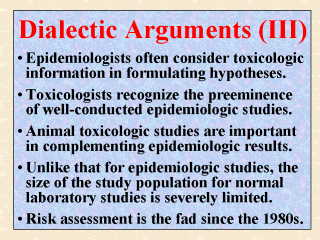| front |1 |2 |3 |4 |5 |6 |7 |8 |9 |10 |11 |12 |13 |14 |15 |16 |17 |18 |19 |20 |21 |review |
 |
According to
Craigmill et al. (1994), "Toxicology and epidemiology are inextricably linked
in recognizing and regulating chemical hazards." These toxicologist authors further
contended that "Epidemiologists often consider toxicological information in
formulating hypotheses, which are then tested by observation in human populations. . . .
Toxicologists, in contrast, recognize the preeminence of well-conducted, human
epidemiological studies, which provide direct evidence of an association between a
chemical (or other factor) and human disease, without extrapolating between species and
across tremendous dose ranges." The authors also praised the role of animal
toxicologic studies in complementing the results of epidemiologic studies. The limitations and advantages of toxicology versus epidemiology were presented earlier by Nelson (1988), whose findings not surprisingly were similar to the observations noted above and in the last two slides. Nelson also pointed out that unlike that for epidemiologic studies, the size of the study population for normal laboratory studies is severely limited. About two decades ago, Frawley (1981) predicted that health risk assessment would become the fad of the 1980s. Craigmill et al. extended Frawley's prediction asserting that the fad would continue through the 1990s. This series of lectures would like to make a further extension that the fad shall prevail at least through the first decade of the 2000s, as to some extent this trend is evident from the recent developments by USEPA (1999, 2000) on aggregate and cumulative risk assessments. |